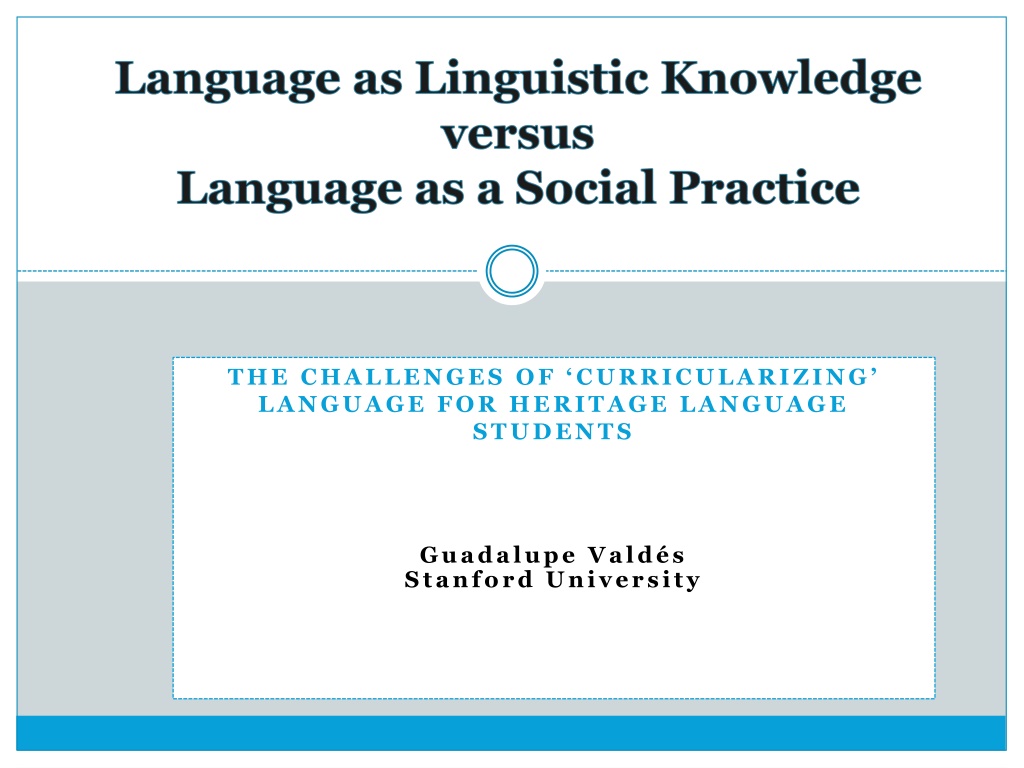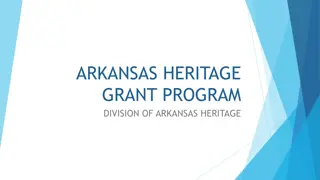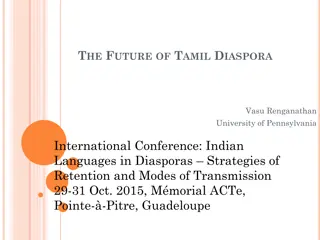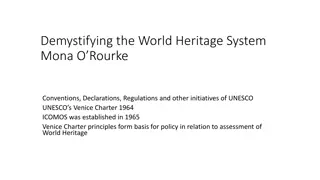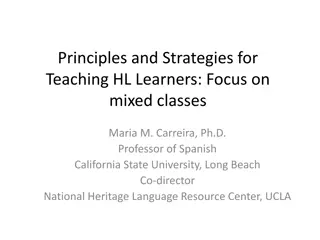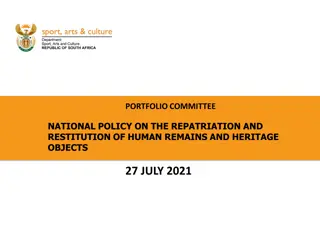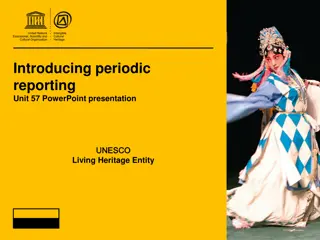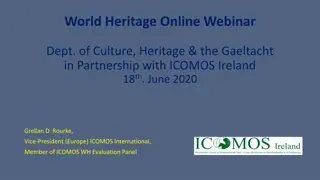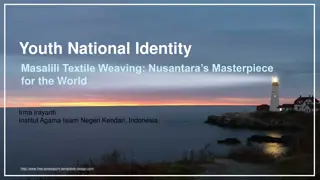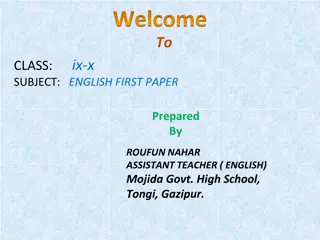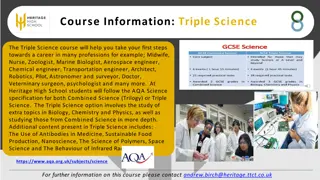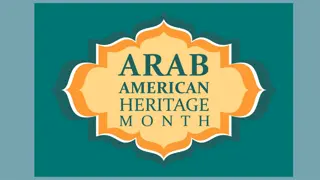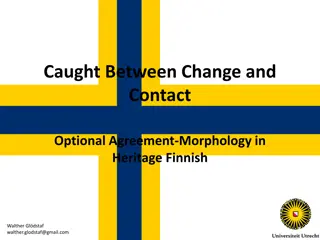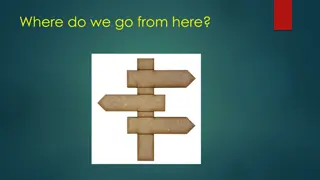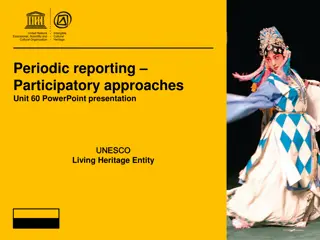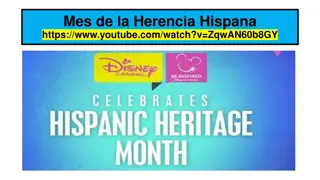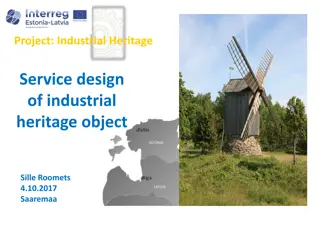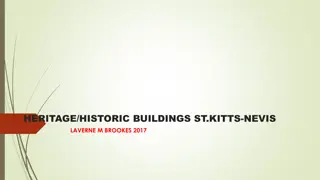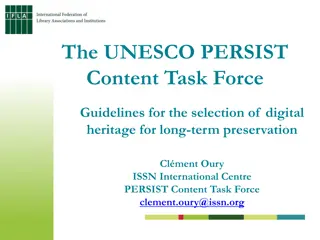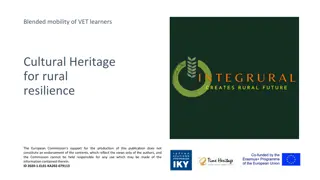Challenges of Curricularizing Language for Heritage Language Students
The field of Heritage Language Education has shown growth and importance in recent years, with a focus on teaching minority languages for various purposes. Researchers are studying heritage languages spoken around the world. Despite progress, there is a tension between common goals in HL education and the unique characteristics of individual languages. The example of Spanish, a widely spoken language with historical and present significance, highlights the complexities and global implications of language education.
- Heritage Language Education
- Minority Languages
- Language Preservation
- Spanish Language
- Linguistic Imperialism
Download Presentation

Please find below an Image/Link to download the presentation.
The content on the website is provided AS IS for your information and personal use only. It may not be sold, licensed, or shared on other websites without obtaining consent from the author. Download presentation by click this link. If you encounter any issues during the download, it is possible that the publisher has removed the file from their server.
E N D
Presentation Transcript
THE CHALLENGES OF CURRICULARIZING LANGUAGE FOR HERITAGE LANGUAGE STUDENTS Guadalupe Vald s Stanford University
Heritage Languages In the last several years the new emerging field of Heritage Language Education (HLE) has grown in important ways. Many scholars around the world are focusing on the teaching and learning of minority languages in a variety of contexts for a variety of purposes.
Much as been accomplished Truly Uncommonly Taught Languages (Gambhir, 2002) are being added to the existing menu of languages commonly taught in schools, colleges, and universities in many parts of the world. Important basic research is being carried out on the characteristics of varieties of heritage languages spoken in communities around the world. There is much that those of us who work on non- dominant or non-majority languages and education share.
Encouraging as this growth is: There is an underlying tension between a commonality of purpose across the field of HL education and the particularity and specificity of language and language circumstances that characterize the various languages that we teach.
Spanish, for example: Is a very large language that is spoken by over 400 million persons in the world and by 50 million people in the United States. Has a long history as an established modern language in the American secondary and post- secondary curriculum. Is currently the foreign language with the largest enrollment at both secondary and post-secondary levels (Furman, Goldberg, & Lusin, 2010).
Moreover Spanish is currently emerging as a global language in ways that require examination and that are not parallel to other European and non-European languages. Mar-Molinero & Paffey (2011), for example, speak of the process of globalization of Spanish in terms of linguistic imperialism and argue that Spanish as a product or commodity is being promoted and enhanced by global media and communications.
These scholars critique Spains pan-Hispanic policy, and contend that: Spain is imagined as the custodian of castellano and responsible for safeguarding a unified Spanish modeled on the central peninsular variety because of its supposed purity from the effects of language contact and borrowings (p. 757). They also contend that: the spread of Spanish means that the global interdependence of Spanish-speaking communities to one another and to other parts of the world system has a significant impact on the language itself (p. 752).
In this presentation: I am concerned about the process of curricularizing language for Latino heritage language students in the light of the position of Spanish both in the world and in traditional language departments in the United States.
I will first talk about definitions of language and suggest that agreeing on definitions is fundamental to the process of planning, selecting and sequencing language elements to be taught or learned. I will then talk about why teaching heritage students must involve a definition of language that is informed by an understanding of bilingualism and of multi-competent individuals who use two languages in their everyday lives.
Definitions of Language According to recent work in applied linguistics: (e.g., Seedhouse, Walsh & Jenks, 2010) teaching languagerequires that we agree on: What we mean by language. What is it that has to be learned/taught given that definition of language. What is it that needs to be taught given different learner characteristics and goals. What we know (and don t know) about how those aspects of language are learned. What we know about how teachable these aspects of language are in a classroom context?
Cook (2010) proposes six definitions of language (I have added a 7th) Lang 1 Lang 2 Lang 3 Lang 4 Lang 5 Lang6 Lang7 a human representation system an abstract external entity a set of actual or potential sentences the possession of a community the knowledge in the mind of an individual a form of action an academic subject that is studied in a classroom setting
These definitions: Are clearly different Give rise to dramatically different assumptions about both teaching and learning: languages. Have led to existing debates in the field of second language acquisition (SLA) --and more recently also in the field of heritage language acquisition (HLA) -- acquisition because researchers may not be aware that they are starting with vastly different conceptualizations of language.
Currently within the field of SLA One group of researchers sees the acquisition of an L2 as an individual cognitive process that takes place in the mind of individual learners. Another group of researchers see language acquisition primarily as a social process that takes place in interactions between learners and speakers of the target language. The positions of the groups of researchers that embrace these two perspectives are so distant that Zuengler and Miller (2006) have characterized the SLA field as currently divided into two incommensurable parallel worlds.
Recently also Perspectives on language have been further challenged by researchers working primarily in multilingual contexts. These scholars (Auer (2007), Heller (2007), Makoni & Pennycook (2007), Rampton (2006) challenge the field of linguistics itself and its fundamental understandings about language.
Heller (2007) Argues against the accepted view of bilingualism as the coexistence of two linguistic systems. Critiques previous scholarship Weinreich s (1953), Mackey(1968), Ferguson (1964), and Fishman (1968) as remaining resolutely committed to a paradigm in which languages are understood as whole, bounded systems, associated, moreover with whole, bounded communities (p.11). Proposes a reorientation that views bilingualism as a complex set of practices which draw on linguistic resources that have been conventionally thought of as belonging to two different systems.
Auer (2007) Criticizes traditional approaches to the study of bilingualism for its construction of bilingual speakers as non-successful cases of L1 or L2 acquisition and as individually deviant because they are not perfect monolinguals, or two monolinguals in one. Asserts that bilingual discursive and linguistic practices present a challenge to linguistics and to assumptions of bound linguistic systems that are the established objects of linguistic research.
Poses questions to be answered by future research: (1) Where does one language stop and the other start in bilingual talk? (2) Where does code switching/mixing belong--to grammar or performance? (3) Are the languages used in bilingual talk the same languages that are used in monolingual talk? (p.121).
Rampton (2006) Critiques twentieth-century linguistics as centrally concerned with regularity in grammar and discourse and focused on speech communities as a body of people who interact regularly. Contends that traditional linguistics has privileged linguistic structure and viewed language use merely as the output generated by semantic, grammatical and phonological systems. Contrasts the practice perspective with traditional linguistic analysis saying: instead of the linguistic systems being viewed as the main carriers of meaning, meaning is analyzed as an active process of here and now inferencing ranging across all kinds of percept, sign and knowledge (p. 16-17)
Makoni & Penneycook (2007) In their book titled Disinventing and Reconstituting Languages start out with the premise that languages, conceptions of languageness, and the metalanguages used to describe them are inventions (p. 1). Argue that the discipline of linguistics itself and even preservationist efforts focusing on endangered languages are founded on conceptualizations of languages as countable entities and of speakers who adhere to monolingual definitions of language proficiency.
Emphasizing that inventions have material effects, these scholars propose both the disinvention of even positive notions of language (additive bilingualism, heritage languages, endangered languages, hybridity). Suggest a reconstruction of static notions of language that allow Jacquemet s (2005) conceptualization of transidiomatic practices defined as the communicative practices of transnational groups that interact using different languages and communicative codes simultaneously present in a range of communicative channels both local and distant (p. 30).
Kooks? Charlatans? Blasphemy? Work drawing from research on multilingual communities, on migration, on global Englishes, and rapidly changing modes of communication has problematized the discipline of linguistics, its structural-functional perspective as well as treasured icons of liberal linguistic thought (Makoni & Pennycook, p. 22) that depend on notions of discrete languages such as language rights, mother tongues, and code-switching.
Current positions expressed in the debates in SLA Are not as extreme. Do reflect a dissatisfaction with the psycholinguistic perspective on language acquisition and with the focus on individual cognitive processes that has been dominant in mainstream SLA.
Current positions expressed in the debates in SLA Are not as extreme. But do reflect a dissatisfaction with the psycholinguistic perspective on language acquisition and with the focus on individual cognitive processes that has been dominant in mainstream SLA.
In mainstream SLA Researchers focus on the study of internal mental processes involving the development of the internal linguistic system of learners. They view language as a mental construct and learning as change in a mental state. They are interested in the aggregation of and increasing complexity and control of linguistic structures by learners, and they measure progress by where along the route toward target language proficiency the learner is as indicated by the learner s linguistic performance (Larsen-Freeman, 2007, p. 780).
Socially-oriented SLA Socially oriented theorists argue that the cognitivist orientation views learners from a deficit perspective and focuses on learners limitations and their failure to become identical to native speakers. These theorists criticize mainstream SLA researchers for taking the position that what is to be acquired is a stable a-priori system that is used only for the transfer of information from one person s mind to the other (Mori, 2007, p. 850). Lafford characterizes this same perspective as decontextualized minds learning grammatical rules (Lafford, 2007, p. 742).
The socially oriented position considers that SLA rather than focusing exclusively on the developing linguistic systems of learners-- should be concerned with understanding how speakers of one language become users (speakers, writers, readers) of a second language. For these researchers, the goal of second language learners is not to become like educated native speakers of the language but to use the language to function competently in a variety of contexts for a range of purposes.
Beliefs about Complexity, Accuracy, Fluency (CAF) Are now increasingly being questioned from a variety of perspectives as evidenced by the special issue of Applied Linguistics that appeared on the topic in 2009 (Housen & Kuiken, 2009). Norris and Ortega (2009), for example, raise serious questions about the evidentiary logic that underlies existing research. They point out that complexity, accuracy and fluency are complex subsystems made up of multiple parts and that because they are growing and changing dynamically, it is extraordinarily difficult for researchers to capture the development of these systems over time and in relation to each other.
In her overview of the issue, Larsen-Freeman (2009) concludes that the study of CAF: has perhaps reached a point where the typical (reductionist) approach of taking factors one by one to see what effect each has on learner performance in a linear causal way does little to advance our understanding (p. 582). She argues for the perspective of complexity theory which rejects expectations of linearity in the development of language. She points out, moreover that learning is not the taking in of different linguistic forms in an aggregative manner; it is changing the system (p. 584).
Do SLA debates apply to Spanish heritage learners? In 2005, I defined heritage language learners as: individuals who are raised in a home where a non-societal language is spoken and who are to some degree bilingual in both that non-societal or minority language and the majority language (Vald s, 2005). This is a proficiency definition as opposed to a personal interest definition.
SHL students are bilingual (L1/L2 Users) who: Have acquired two knowledge systems--or a single system (Matras, 2010)-- that they use in order carry out their particular communicative needs, needs that may be quite unlike those of monolingual native speakers who use a single language in all communicative interactions. May have not only two or more sets of rule complexes from their languages, regulating their communicative performance, but at least three, the third complex arising from LX which consists to a large extent of items from both languages(Oksaar, 1997).
Grosjean(1997) contends that : At any given moment, bilinguals are in states of activation of their languages and language processing mechanisms that are either monolingual or bilingual. Depending on the base language used and the interlocutors involved, an L1/L2 user will be either in (1) a monolingual mode in language A, (2) a monolingual mode in language B, or (3) a bilingual mode.
While in one or the other of the monolingual modes, the other language is deactivated to some extent and transfer between the two languages is reduced. In the bilingual mode, however, because both languages are active, transfer between the two languages as well as the tendency to code-switch will be evident to a greater degree. Since language behavior in different modes most probably reflects how bilinguals process their two languages, research on bilingual competence and performance must take into account language mode.
The notion of the native speaker has been problematized extensively (e.g.,Davis, 1991, 2003;Doerr, 2009) Kramsch, 1997) And as Cook (1997) emphasizes: L2/L2 users do not have the opportunity of using two languages to carry out the exact same functions with all individuals with whom they interact or to use their languages intellectually to the same degree. They thus do not develop identical strengths in both languages. More importantly, perhaps, is it not the case that all monolingual native speakers would be successful if measured against the norm of the educated native. It thus makes little sense to use a monolingual native-speaker norm to evaluate the competence of L1/L2 users. It is not clear why we should ever compare two types of people in terms of a bookkeeping exercise of profit and loss (Cook, 1997:294).
L2 Learners and SHL Students in Spanish Language Programs Spanish Literature Program Basic Spanish Language Program SHL Students L2 Students
L2 Learners and SHL Students May have little in common. We compare them only because of the structure of foreign language departments in this country. SHL students fulfill language requirements in our departments; They enroll in our classes; We curricularize language We establish goals for their learning. We select language content. We measure their achievement.
Following Tomlinson (2007), I would argue that: L2 Spanish learners are engaged in acquisition, that is, in the initial stages of acquiring linguistic and communicative competence. SHL are engaged in development, that is, in the subsequent stage of gaining the ability to use the language successfully in a wider range of media and genre for a variety of purposes (p.2).
Curricularizing Language (Nation & MacCalister, 2010) Theory of Language Theory of Language Acquisition/Development Analysis of Environment Needs Analysis Development of Instructional Principles Definition of Goals of Instruction Selection and Sequencing of Content Selection of Methods and Approaches Monitoring and Assessment
In the case of SHL Students Instructional Principle Selection of Content Theory of Language Goal of Instruction Students must have the opportunity to acquire forms and structures not yet acquired Students will develop monolingual native-like proficiency Language is structure ??? Students must have the opportunity to use the language in Latino communities Students will develop the ability to use Spanish for personal/professio nal purposes Language is a social practice ???
According to Uricuoli (2010) at the postsecondary level: For Spanish HL students, the Spanish they grew up with has a complex relation with Spanish as an academic subject (p.257). Knowing Spanish in college and university settings: Can be part of a pan-Latino identity. Can cause push students to uncomfortable, metalinguistic reflection at school, where correctness is a constant concern (p.270). Can result in students viewing Spanish correctness norms as part of a marketable commodity.
Curricularizing Spanish for SHL students: I have argued elsewhere (Vald s, 2006) that in order to design instruction aimed at developing the unique language strengths of heritage language learners, a systematic research agenda needs to be put in place that can guide the multiple aspects of this research. This agenda must focus, not only on the linguistic/pragmatic characteristics of heritage learners, but also on the role of instruction in the development/ re-acquisition of non-dominant L1 s.
Such an agenda must: Develop language assessment procedures that can identify key differences among heritage learners as multi-competent users of two languages. Investigate the implicit systems and communicative social practices of different types of heritage learners in their non-dominant L1 s. Distinguish whether differences between HL learners and between HL learners and monolinguals are due to what has been termed incomplete acquisition /or to the emergence of new varieties of the language (Kerswill, 2010).
Determine the degree of system restructuring that would need to take place in order for heritage learners of different types and proficiencies to carry out particular functions in particular settings using appropriate linguistic forms. Investigate the role of different types of instruction in such restructuring for different types of heritage speakers.
Moving forward In moving forward in the teaching of heritage languages, we must: Keep in mind the particularity of the languages that we teach. Recognize that different definitions of language give rise to dramatically different assumptions about both teaching and learning languages.
Much is changing The notion of incomplete acquisition as measured by normative assessments is now being problematized (Rothaman & Iverson, 2010; Cabo & Rothman, 2012) Usage Based Linguistics (UBL) has been proposed as a way forward for the bi/multilingual turn in SLA (Ortega, 2014).
There is much to be done There are no single answers. However, we need to be aware of: The complexity of the issues The importance of making clear our different conceptualizations of language our different theories of language acquisition/development our various perspectives and processes for curricularzing language.
